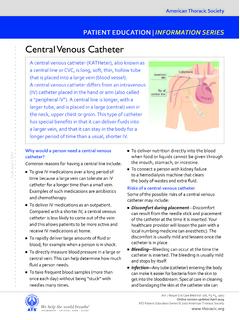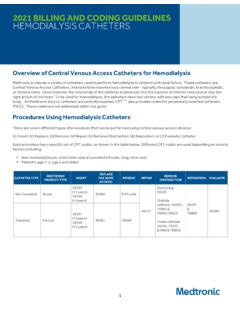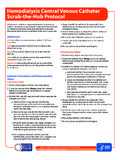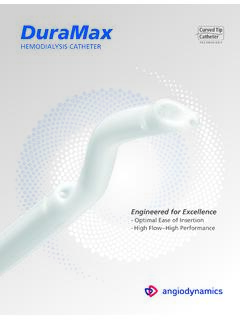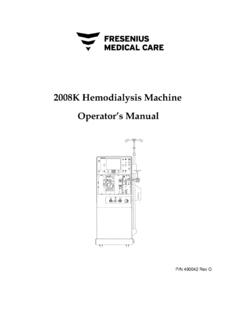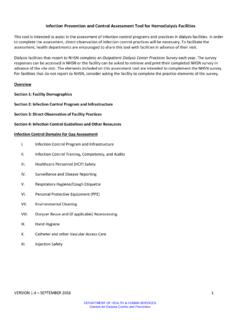Transcription of DESIGN PRINCIPLES: HEMODIALYSIS MACHINE
1 DESIGN principles : HEMODIALYSIS MACHINE Prof. Yasser Mostafa Kadah EE 497 Spring 2015 Recommended Reference Allen R. Nissenson and Richard N. Fine (Eds.), Handbook of Dialysis Therapy, 4th ed., Saunders Elsevier, Philadelphia, 2008. (ISBN: 978-1-4160-4197-9) HEMODIALYSIS MACHINE HEMODIALYSIS Machines Single-patient HEMODIALYSIS machines deliver a patient s dialysis prescription by controlling blood and dialysate flows through the dialyzer. Removal of waste metabolites Removal of water HEMODIALYSIS machines incorporate monitoring and alarm systems that protect the patient against adverse events that may arise from equipment malfunction during the dialysis treatment.
2 HEMODIALYSIS System Components (C = conductivity monitor, P = pressure monitor, T = temperature monitor) Extracorporeal Blood Circuit Consists of an access device (needles or catheter ), blood tubing, blood pump, and dialyzer. Includes a pump for continuous administration of heparin during dialysis. Role of the blood circuit is to deliver blood to the dialyzer at the prescribed flow rate and then return the blood to the patient. This goal must be achieved without damaging blood components and without loss of circuit integrity that may lead to blood loss or the entry of air or other harmful substances, such as bacteria, into the blood.
3 Urea clearance depends in large part on effective blood flow rate through extracorporeal circuit. Established using a roller pump (also known as a rotary peristaltic pump) that allows flows in the range of 50 to 600 mL/min. Blood flow rate setting on the pump is based on the speed of the pump (revolutions/minute) and the volume of pump segment of blood tubing set. Extracorporeal Blood Circuit Peristaltic pump Safe for blood cells: minimal hemolysis Safe from cross-infection since disposable blood line is used inside Can be operated manually in cases of power outage Speed controlled by system and also manually Dialysate Circuit Principal functions of the dialysate circuit.
4 To prepare dialysate from concentrate and water To deliver it to the dialyzer at the prescribed temperature (generally 35 37 C) and flow rate To control fluid removal from the patient Dialysate is prepared by the addition of electrolyte concentrate to warmed and deaerated water. two separate concentrates must be used to prepare dialysate Bicarbonate concentrate contains sodium bicarbonate, and in some cases some sodium chloride. Acid concentrate contains all remaining dialysate constituents, a small amount of acid needed to buffer bicarbonate in final dialysate Dialyzer Hollow fiber technology Many fine fiber tubes to allow contact surface area to be large Disposable dialyzers: single patient use to prevent cross-infection Dialysate proportioning systems System A: Fixed-volume proportioning of water, acid concentrate, and bicarbonate concentrate.
5 System B: Dynamic proportioning using conductivity measurement to control the acid and bicarbonate concentrate pumps. System C: Dynamic proportioning using a powder cartridge to prepare the bicarbonate concentrate online A = acid concentrate B = bicarbonate concentrate CM = conductivity monitor CS = conductivity set point Dialysate proportioning systems Several ratios of concentrate to water in common use depending on system 1 , 1 :34, and 1 (acid conc: bicarbonate conc: water). Each proportioning ratio requires its own particular acid and bicarbonate concentrates.
6 Some machines are designed for use with a single proportioning ratio, whereas other machines can be set to use different proportioning ratios. Because machines monitor dialysate composition based on conductivity, use of the wrong concentrates can lead to dialysate of the correct conductivity but the wrong composition. Therefore, failure to use the correct MACHINE setting or to use the correct concentrates with a given MACHINE can lead to patient injury. Fluid Removal: Ultrafiltration Older systems: no direct control Tricky and depends on dialyser properties and control of pressures error leads to excess water removal Current systems: volumetric control System A: Flow sensor-based system System B.
7 Balancing chamber system Left side of the balancing chamber meters fresh dialysate and the right side meters spent dialysate Flow sensors limit dialysate flow rate No limitation with balancing chamber Cleaning and Disinfection HEMODIALYSIS machines must be cleaned and disinfected regularly to prevent buildup of chemical and bacterial deposits in the dialysate flow path Such deposits can interfere with conductivity-based monitoring systems and flow-meter based ultrafiltration control systems To prevent the chemical buildup of carbonate deposits, machines are rinsed with acetic acid (vinegar) or citric acid To prevent bacterial buildup, machines must be disinfected at least daily with a chemical disinfectant such as sodium hypochlorite (bleach)
8 Some machines also incorporate a hot water disinfection cycle Monitoring and Control Safety Monitors in HEMODIALYSIS Dialysate Circuit Prepare the dialysate solution for safe exposure to the patient s blood Monitor the dialysate for conductivity and temperature Circulate the dialysate through the dialyzer Regulate ultrafiltration by volumetric control of the dialysate Monitor the effluent dialysate for blood leaks prior to going to the drain Blood Circuit Circulate the blood outside the body through the dialyzer Anticoagulate the patient s blood Maintain blood in a sterile state Monitor the extracorporeal blood circuit for arterial and venous pressures and the integrity of the circuit for the presence of air and blood leaks Control Panel and Monitor Display Monitor Failure All monitors can fail (mechanical, electrical or combination) Murphy s law: If anything can go wrong, it will MACHINE monitors are frequently thought to be fail-safe devices, but they are not.
9 A truly fail-safe device cannot be overridden to cause harm either by electronic or human intervention obviously not the case in HEMODIALYSIS Because all dialysis MACHINE monitors can fail, they ought to be simple to operate and accurate and should signal a warning when they are out of limits or not working properly. Human factors engineering principles Any important factor requires dual monitoring: the MACHINE monitor device and dialysis personnel. No MACHINE , computer, or device can replace the continuous surveillance of HEMODIALYSIS personnel.
10 Dialysate Circuit Dialysis Monitoring Heater monitoring Thermistor feedback circuit usually controls electrical heating elements Heater may have a coarse adjustment control inside the MACHINE and a fine adjustment control on the front panel Deaeration monitoring Observable by eye and relies on vacuum pump and proper interconnects hidden cause of several serious dialysis problems, such as False blood-leak alarms, False conductivity alarms, Interference with volumetric control function, Decreased dialysis efficiency Dialysis Monitoring Mixing Device Monitoring Typical mixing ratios of water to dialysate concentrate are: 34:1 or 44:1 for acid concentrate 20:1 or 25:1 for bicarbonate concentrate If acid and bicarbonate inputs are reversed, or if the wrong concentrates are used for a bicarbonate MACHINE , the servo loops may make a solution of acceptable ionic strength (correct conductivity) but of lethal ionic composition.
